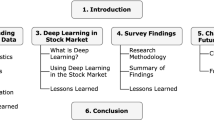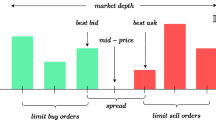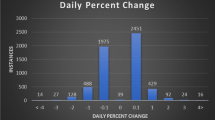Abstract
We show how and why to use a financially meaningful differential regularization method when pricing options by Monte Carlo simulation, be that in polynomial regression or neural network context.







Similar content being viewed by others
Notes
Over the last decade the Bachelier model has had a revival in quant circles. There are several reasons for this: It is born with a negative skew in implied volatilities, things we thought were positive have gone negative (interest rates—even oil prices), and working with constant (rather than proportional) coefficients is mathematically easier—as for instance in Jesper Andreasen and Brian Huge’s work (Andreasen & Huge, 2012) on option pricing via expansions.
Both of the operations are what mathematicians would call formal, i.e. not rigorously justified, but let’s not worry about that here; it can be fixed [(Broadie & Glasserman, 1996, Appendix A), L’Ecuyer, 1995] with the theory of generalized functions—or verified by elementary means for the Bachelier (and the Black–Scholes) model.
In the recurrent example in this paper one can safely use \(w= 1/2\) as prices and Deltas are of the same magnitude. In general we suggest using \(w = sd (D)/ (sd(C) + sd(D))\), where sd denotes standard deviation. This ensures that terms in the “naked” version of Eq. (4)—i.e. when \(\theta = 0\)—have the same variance.
To make dimensions fit snugly, Y starts with a zero-column, so strictly speaking Eq. (5) can’t be used for \(w= 0\).
For a non-infinitesimal hedge frequency, say \(dt =1/52\), we cannot say that the discrete use of the continuous \(\varDelta\) gives the lowest hedge error standard deviation. In fact, as shown by Wilmott (1994) we can do slightly better when rates are non-zero. However, (a) we have results that ensure dt \(\rightarrow 0\)-convergence and (b) rates are zero here, so we ignore that.
We could increase the range parameter d or change to an estimation method that does not explicitly invert matrices.
Handling the square and particularly the sum part of the criterion function efficiently does require thought – but of a different (vectorization) nature.
Here we are skipping a bunch of nasty details regarding matrix multiplication, differentiation and restrictions on input and output dimensions.
References
Andreasen, J., & Huge, Brian. (2012). ZABR—Expansions for the Masses. Working paper at http://ssrn.com.
Bishop, C. (2006). Pattern recognition and machine learning (2nd ed.). Springer.
Björk, T. (2020). Arbitrage theory in continuous time (4th ed.). Oxford.
Boyle, P., Broadie, M., & Glasserman, P. (1997). Monte Carlo method for security pricing. Journal of Economic Dynamics and Control, 21, 1267–1321.
Broadie, Mark, & Glasserman, Paul. (1996). Estimating security price derivatives using simulation. Management Science, 42(2), 269–285.
Giles, M., & Glasserman, P. (2006). Smoking adjoints: Fast Monte Carlo Greeks. Risk. p. 88–92
Huge, B., & Savine, A. (2020). Differential machine learning: The shape of things to come. Risk. p. 76–81
L’Ecuyer, P. (1995). On the interchange of derivative and expectation for likelihood ratio derivative estimators. Management Science, 41(4), 738–748.
Leshno, M., Lin, V. Y., Pinkus, A., & Schocken, S. (1993). Multilayer feedforward networks with a nonpolynomial activation function can approximate any function. Neural networks, 6(6), 861–867.
Longstaff, F. A., & Schwartz, E. S. (2001). Valuing American options by simulation: A simple least-squares approach. Review of Financial Studies, 14(1), 113–147.
Musiela, M., & Rutkowski, M. (1997). Martingale methods in financial modelling (2nd ed.). Springer.
Telgarsky, M. (2015). Representation Benefits of deep feed forward networks. At arXiv arxiv:1509.08101
Wilmott, P. (1994). Discrete charms. Risk. p. 48–51
Author information
Authors and Affiliations
Corresponding author
Additional information
Publisher's Note
Springer Nature remains neutral with regard to jurisdictional claims in published maps and institutional affiliations.
Thanks to MathFinance Conference 2021 participants.
Rights and permissions
About this article
Cite this article
Frandsen, M.G., Pedersen, T.C. & Poulsen, R. Delta force: option pricing with differential machine learning. Digit Finance 4, 1–15 (2022). https://doi.org/10.1007/s42521-021-00041-7
Received:
Accepted:
Published:
Issue Date:
DOI: https://doi.org/10.1007/s42521-021-00041-7




